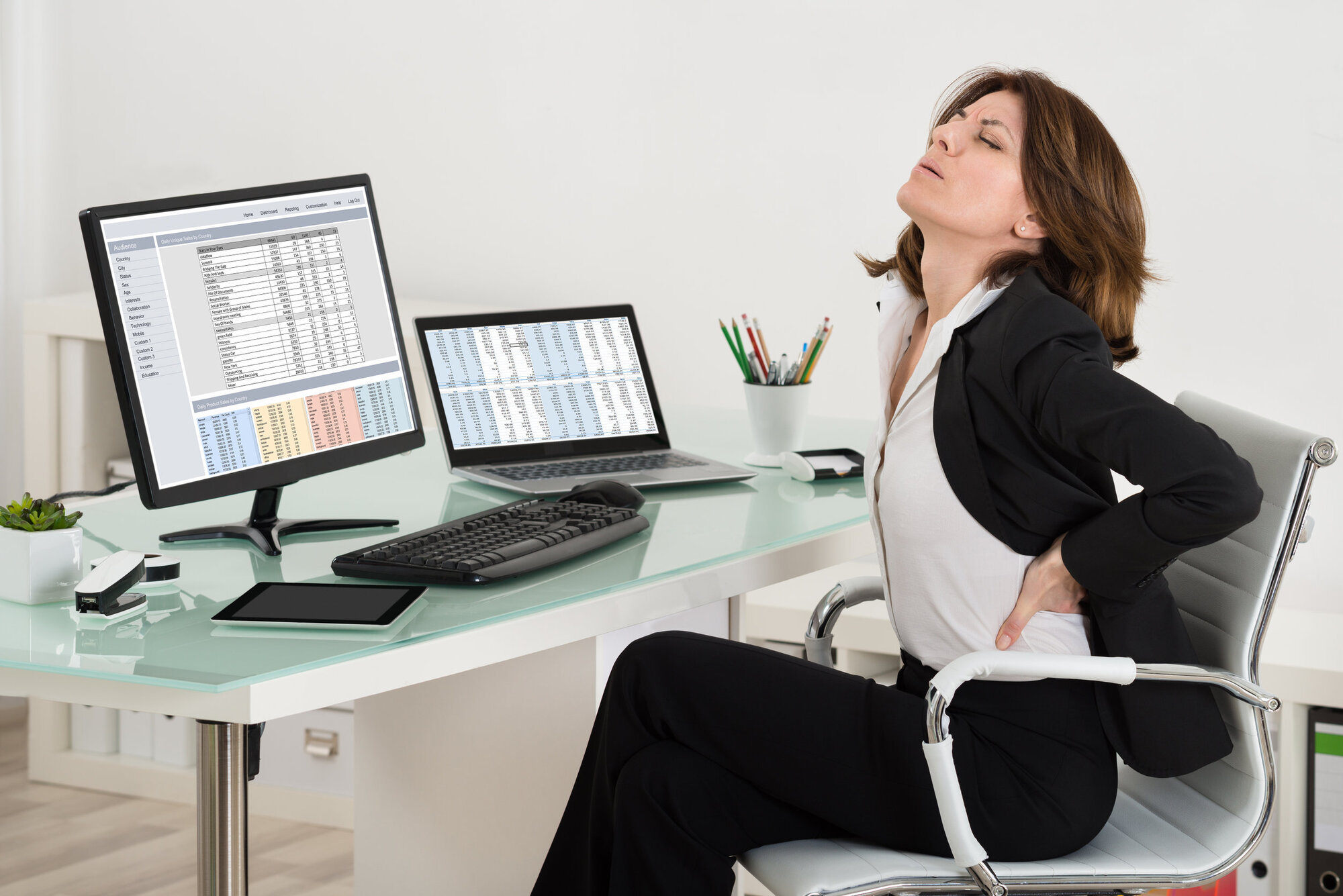In this article
Download our free PDF DSE Workstation template here.
Did you know that by the end of 2020 about 94% of homes in the UK had internet access, according to Ofcom research? That is almost the entire population having digital devices to use in their own homes. This includes a mixture of using mobile phones, tablets, desktop PCs and laptops.
As well as at home, computers are an integral tool used in almost all work and study settings, supporting tasks including internal and external communication, conducting research, storing files, marketing to customers, and running e-commerce. This covers practically all functions in most businesses; meaning that a large proportion of the workforce is likely to use a computer or laptop every day.
If you think about how much time you may spend in front of a screen, the chances are that it is a considerable proportion of your day. Research by TechRound found that UK adults could spend over half of every day in front of a computer screen. Understandably, this prolonged time in one position can cause injuries and health risks.
It can cause musculoskeletal injury, eye strain and headaches, to name a few. To prevent this, there is guidance in place to support computer users to prevent injury and use devices healthily, which will be explained throughout this guide.
What is health and safety for people using computers?
There are many health and safety problems that can be linked to the use of computers. So health and safety measures have been put in place to help avoid injury.
These measures are embedded into legislation for employers and employees to follow to ensure computers are used responsibly. The legislation covers a range of factors relating to computer use, which form the basis of a workstation risk assessment (which we have outlined below):
Workstation risk assessment
A workstation risk assessment is used to ensure that each individual worker has the correct equipment to enable them to work comfortably in front of the computer. This is engrained in health and safety legislation to help the workforce prevent injury. It includes an assessment relating to the computer features remaining in this list.

The computer monitor
The computer monitor is the screen that you look at whilst you are using the computer or laptop. Many postural and eyesight health problems can be as a result of not having an appropriate computer screen for your intended use. For example, if you are going to be sat at your computer for a long period of time, you can get eye strain if your screen is not big enough, or the correct brightness. You can also cause a postural injury if the top of your computer screen is not at your eye level to prevent you from slouching.

Computer chairs
Sitting anywhere for a long period of time can be uncomfortable. However, not sitting in a chair with the proper postural support for your size can cause significant injury or postural problems. When considering computer chairs as part of health and safety, other items such as a footstool can be incorporated to help you sit more comfortably in the chair.

Workstation set-up
Having the items that you use frequently in close reach of your workstation can help you to avoid strain. However, having too many items around your workstation can also cause you to position yourself incorrectly as you try to avoid the clutter, which could cause repetitive strain injury.

Using laptops
Laptops are becoming increasingly popular due to their smaller size and convenience when travelling. They can also be used outside of the office, as more workplaces offer increasingly flexible working patterns. However, they also present the risk of poor posture; because of their smaller size people may often lean forward when working on them.

The wider environment
The environment that you are working in can have an impact on your physical health. For example, if the room you are using your computer in has extremely bright lights or high temperature it can instigate headaches and migraines.

Taking breaks
Taking a break forms part of computer health and safety. Working in one position for a long period of time can be uncomfortable and risks you having poor posture. It also leads to fatigue which can add to aches, pains and headaches.

What legislation is in place for businesses using computers?
The main piece of legislation that underpins businesses’ responsibility to look after the health and safety of their employees is the Health and Safety at Work etc. Act 1974. It gives duties to employers and employees in relation to staying safe at work.
More specifically, the regulations that apply to computer use are the Health and Safety (Display Screen Equipment) Regulations 1992. These regulations were introduced to cover all people who work using a visual display unit (VDU), which encompasses each new digital development to ensure that it covers all forms of display screen equipment.
The Health and Safety Executive explain that the Health and Safety (Display Screen Equipment) Regulations 1992 are applicable to all workers who use computers for at least an hour or more at a time.
The legislation is in place because surveys found a high proportion of computer users reported aches, pains and eye discomfort after prolonged use. It places responsibility on employers to ensure that they handle the risk of employees using display screen equipment for the specified time.
Why is health and safety important when using computers?
Health and safety should never be overlooked when using computers as it can help to prevent a number of health issues including:
- Repetitive strain injury (RSI) – RSI can occur when you complete the same movement repeatedly over a prolonged period of time. When using a computer, RSI is often associated with the fingers, wrists and arms. This because you may not be sat in the correct position for your hands and arms to reach the keyboard comfortably. Continuing to use the keyboard and mouse whilst not in the correct posture can eventually cause the fingers, hands or arms to ache. To prevent this, you should take regular breaks away from the computer so that you can move into a different position. At least a five-minute break is recommended for every hour sat at the computer.
- Posture related injury – Other posture related injury in relation to working at a computer can affect your back, neck and shoulders. This can be as a result of a number of things such as:
– Your display screen not being at the correct height.
– Not having a chair suitable for you.
– Missing a footstool.
– Sitting for too long at the computer without a break.
– Not sitting at a proper desk if you are using a laptop.
– Leaning forward towards the screen causing you to hunch your neck, back and shoulders.To resolve this, you should take regular breaks and ensure that you are comfortable at your workstation. - Eye strain – Eye strain can be caused by a number of factors when working at a computer, such as the brightness of the room and screen, unknowingly needing glasses or contact lenses, and not taking regular breaks away from the screen. To resolve this, you should ensure the lighting is appropriate for the room, your screen is not flickering and is the right brightness for you, take regular breaks, and ensure that you have had an eyesight check.

Employer regulations and responsibilities
It is the employer’s responsibility to provide all of their employees who use computers with a risk assessment when they start work. Completing an analysis of individual workstations allows employers to appropriately manage the risk of injury to their workforce.
When completing a workstation analysis for an employee, the employer must look at the following elements:
- Furniture including desk, chair and footstool.
- Environment including assessing level of noise, temperature, lighting and space.
- Software on the computer, ensuring it is suitable for the working tasks.
- The computer screen, ensuring the height, size, stability and ability to tilt is suitable.
- Position of the computer mouse.
- Position of the computer keyboard.
- The length of time the employee will be working at the computer.
- Any individual needs or health conditions.
- Offer a free eyesight test and pay for any glasses if identified as a result, to improve the person’s ability to work at a computer.
- Provide training on how to work safely at your workstation.
Depending on the size of your business, you should have occupational health professionals, or at least a human resources team, to help address any risks a person may have when working at a computer. The Equality Act 2010 can also be used to make reasonable adjustments to support an employee to complete their job.
For example:
An employee may suffer frequently with migraines which can be exacerbated by bright lights. To manage this risk, the employer could dim the lighting where the employee sits and provide screen overlays to reduce the brightness of their monitor. These small adjustments would support the employee in their work duties whilst reducing the risk of injury or fatigue from sitting at the computer.
Employee regulations and responsibilities
Employees should also take responsibility for their own health and safety at work. As an employee, it is up to you to co-operate with your employer to protect yourself from injury from computer use. Often when you start work at a new workplace, you will be provided with training or e-learning that covers health and safety in relation to display screen equipment.
It is your obligation under health and safety legislation to comply with the training and work according to its advice. You should report any concerns as soon as possible and manage your time effectively during the day so that you can take regular breaks away from your desk to look away from the screen and change position. This also applies to people who work from home.

How can health and safety affect businesses using computers?
Having the correct health and safety precautions in place can have a huge positive impact on your business. This is because your workforce will be looked after whilst using computers so that they can avoid injury; which will promote productivity in the workplace.
If an employee has to go off work because they have sustained an injury, this can impact not only them, but the wider team. Their work tasks usually have to be delegated, which puts added pressure on to other team members. This can therefore put other team members at risk of injury from using computers, with them having an increased workload.
The increased workload can cause people to neglect their own health and safety (such as taking frequent breaks), placing them at higher risk of sustaining an injury as well. This can snowball into a staff crisis which could then impact your business’s reputation or reduce your business capabilities. Following the correct health and safety protocols when using computers not only protects your staff, but also protects your business.
How to avoid health and safety issues
There are many tips that can help to avoid health and safety issues in relation to computer use. Some have already been covered in this guide, but we have included a full list below to help you work safely and prevent injury from computer use at work.
Preventing back pain:
- Ensure that you can provide your employees with an adjustable chair with armrests so that it can be tailored to their body shape. Some people may need a footrest to ensure that their feet can be flat on the floor to maintain a good posture.
- Ensure that there is ample space under the desk for your employees to have their feet on the floor comfortably, as this will encourage proper posture.
- Take a break from the computer screen at least once an hour to change your position and have some time away from the screen.
- Do stretches in your chair to prevent keeping the arms and shoulders in the same position for too long.
- Keep your monitor at eye level height so that you do not tilt your neck forward to see your screen (if you are using a laptop, you can plug this into a larger monitor to prevent this).
Preventing eye strain:
- Look away from the screen every 20 minutes using the 20-20-20 rule. This means that you should look away every 20 minutes at something 20 metres away for 20 seconds. This allows the eyes to re-focus and prevent strain.
- Ensure there is no glare or flickering on your computer monitor.
- Use glasses or contact lenses if you are required to.
- Use screen filters to dim the brightness if required.
Preventing repetitive strain injury:
- Ensure that your mouse and keyboard are positioned within easy reach for your use. Your forearms should have contact with the desk when using the equipment to help to avoid straining to reach certain keys.
- Soft touch-typing and mouse use should be encouraged to reduce the impact of the movement on your hand, wrist and fingers.
- Implement a clear desk policy to prevent clutter from causing people to overstretch for their equipment when working.
- Take regular breaks from typing to readjust your posture.






